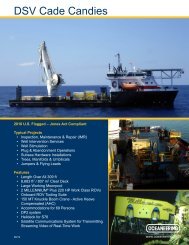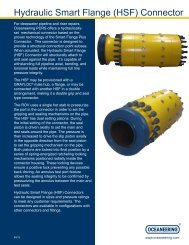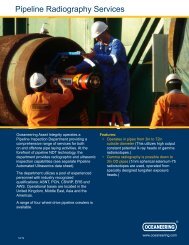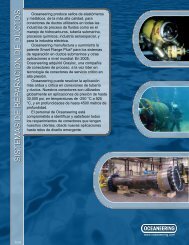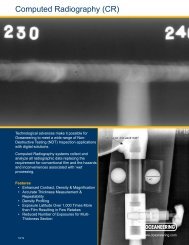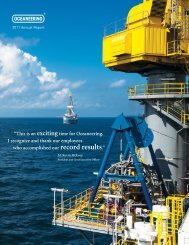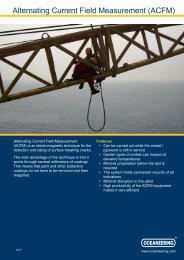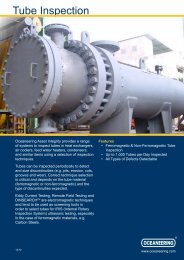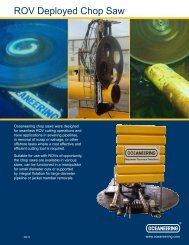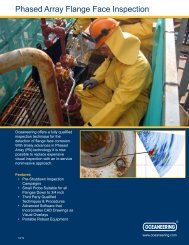INSPECTION STANDARD - Oceaneering
INSPECTION STANDARD - Oceaneering
INSPECTION STANDARD - Oceaneering
You also want an ePaper? Increase the reach of your titles
YUMPU automatically turns print PDFs into web optimized ePapers that Google loves.
THE <strong>INSPECTION</strong> <strong>STANDARD</strong><br />
Nuclear Stations<br />
vessel entry training<br />
A team of 20 <strong>Oceaneering</strong> technicians led by Chris<br />
Smith, NDT Inspection Engineer, have once again<br />
undergone training on boiler simulators located in<br />
Newcastle, England in preparation for completing<br />
inspection work in the most testing of conditions<br />
- boilers in close proximity to the reactor core on<br />
nuclear installations. This work has proved vital to<br />
the efficiency of the boilers in the past although the<br />
conditions encountered could not get much more<br />
challenging.<br />
Due to the heat and potential contamination in the<br />
boilers the inspectors wear air-fed suits and have<br />
to manoeuvre through a complex set of boiler<br />
tubes to get in the correct position to complete the<br />
testing. To apply the ALARP (As Low As Reasonably<br />
Practicable) principle requires practise in safe<br />
conditions. For this reason simulators create the<br />
conditions and work scopes are developed to<br />
allow the inspectors to become acclimatised and<br />
confident in the simulated conditions within a<br />
safe environment before the actual site work is<br />
performed. The inspectors are monitored by video<br />
and radio communications from a manned control<br />
room while completeing the tasks, while keeping<br />
the number of personnel allowed into the hazardous<br />
conditions to a minimum.<br />
Over the past years a vast amount of successful<br />
inspections have been completed on the boilers<br />
due to the diligent attitude of the inspectors and the<br />
professional training completed.<br />
7<br />
Eggborough Power<br />
Station safety award<br />
<strong>Oceaneering</strong> personnel are renowned for<br />
their vigilance and an eye for detail and this<br />
was proved again when a team of technicians<br />
identified a defect with the potential to cause a<br />
significant safety issue.<br />
During the 2011 shutdown, Dale Sutcliffe,<br />
Gary Cook and Carl McElvaney formed the<br />
<strong>Oceaneering</strong> inspection team tasked with carrying<br />
out a routine inspection of a high pressure<br />
pipework bend on Unit 3 Eggborough Power<br />
Station. The coal fired station has been generating<br />
electricity since 1967 and is located in East<br />
Yorkshire, England.<br />
Members of the team noticed a crack propagating<br />
from a ‘tapping point’ branch weld to an adjacent<br />
‘warming’ branch weld. The defect was in an<br />
area outside the area scheduled for inspection.<br />
Nevertheless the alert team immediately reported<br />
to the Station Engineer, an action which resulted in<br />
a change to the inspection scope for this and other<br />
station units.<br />
In recognition of their diligence the three men<br />
were proposed for a Safety Award which<br />
was presented to them by Paul Tomlinson, the<br />
Power Station’s Chief Operating Officer on the<br />
14th of June. <strong>Oceaneering</strong> also recognised<br />
this conscientious approach, by presenting<br />
each individual with a monetary voucher and<br />
expressing great thanks to all involved.<br />
Carl McElvaney - Left Gary Cook - Left




